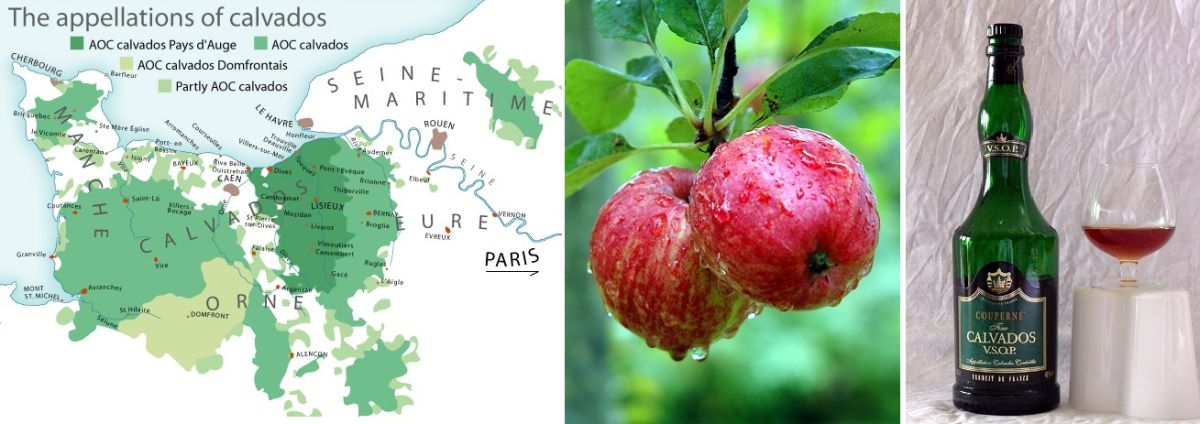Results
2,284 Results
Loading more Results ...
Loading more Results ...
| Calvados IGP |
Description to Calvados IGP
French apple brandy from the department of the same name in western Normandy in the north-west of the country. The area was named after a ship of the Spanish Armada called "El Calvador" that ran aground on the coast. Apples and the cider made from them are also very important here. Alongside Armagnac and Cognac, Calvados is the third famous brandy from France. The first evidence of the production of an apple brandy in Normandy is a royal licence granted to Sire Gilles de Gouberville from Le Mesnil-au-Val in 1553 to distil an "Eau de Vie de Sydre". However, the first mention of the term Calvados dates back to 1884, when the drink became increasingly popular in Paris. A limited area with 11 sections and a specific cider distillation process was recognised as an appellation in 1946. There are three appellations according to the narrower origin with special production rules. These are "Calvados", "Calvados Pays d'Auge" (Eye region) and "Calvados Domfrontais" (30% pears). Around 30% of the Normandy apple harvest is processed into Calvados, 50% into cider and 20% into apple juice.

Other apple brandies
An apple brandy known as eau-de-vie de cidre usually comes from Normandy, but also from Brittany or the Loire in smaller quantities if the brandy is made from cider and does not come from the limited Calvados region, or if its exact origin can no longer be proven. The equivalent of Calvados from Brittany is Lambig (also known as Eau-de-vie de cidre de Bretagne). The ingredients and the production process are identical. Brandies known as eau-de-vie de pomme do not have to be made from cider, but are also produced from fermented cider juice without it having been turned into cider first. They are also known as apple brandy, applejack or aquardiente di sidre.
Production of Calvados
The basis for Calvados is wine fermented from the must of apples and, to a lesser extent, pears. As with cider, 48 varieties of apples and some pears are authorised. As a rule, this should be a mixture of 40% sweet, 40% bitter and 20% sour apples. After fermentation, the cider only has 4% vol., which is why it is distilled twice (fractionated process), just like cognac. The result of the first distillation with approx. 25% alcohol by volume is also known as "petit eau" (small water). After a short period of storage, the second distillation takes place. It must reach 70% vol. Ageing in oak or chestnut barrels gradually makes the initially fruity Calvados fuller and softer. Its colour darkens and its taste takes on the character of brandy with an apple aroma.
Slightly coloured with caramel, but usually unsweetened (therefore very dry), it is reduced to a drinking strength of around 40 to 50% by volume with distilled water after at least one year in oak barrels. This is usually followed by a blend of several vintages. Depending on the age of maturation, there are the designations Fine (at least 2 years), Réserve (at least 3 years), VO or Vieille Réserve (at least 4 years), VSOP (at least 5 years) and XO - also known as Napoléon, Trés Vieille Réserve or Hors d'Age (at least 6 years). Some producers produce Calvados with 15 years of ageing.
Indulgence
In France, Calvados is a popular digestif, but is also drunk between meals to "make room in the stomach". This is known as "faire le trou normand" (making a Norman hole). In the past, Calvados was usually drunk from simple shot glasses. With the AOC classification, thin-walled tumblers with tapered goblets like those used for Cognac were then increasingly used. Calvados is also often served in drinking vessels made of clay or earthenware, the shape of which (three quarters of a sphere) is said to be reminiscent of the skulls of the enemies from which the Normans drank.
IGP wines Calvados
Since 1968, there has been an IGP classification (formerly Vin de pays) for red wines, rosé wines and white wines. There are the AOC designations Calvados Blanc, Calvados Grisy Blanc (since 2009 for the commune of Grisy), Calvados Rouge and Calvados Rosé. They are also produced as Nouveau (Primeur). All grape varieties from the region may be used freely.
Further information
For the production of alcoholic beverages, see Champagne (sparkling wines), Distillation (distillates), Spirits (types), Winemaking (wines and wine types) and Wine law (wine law issues).
Map: By Henrik mattson, CC BY-SA 2.5, Link
Apples: By Harald Bischoff - Own work, CC BY-SA 3.0, Link
Calvados bottle: By User: Mahlum - Own work, Public domain, Link
More information in the magazine
- Plaimont - The vine rescuers from south-west France Advertisement
- Good Bordeaux doesn't have to be expensive! Crus Bourgeois
- Paradisiacal times! Tasting: European sparkling wines for the festive season
- Liv-ex classification: The fine wine market 2023 France is the measure of all things
- Domaine Combier Collection of the Year 2022 - Rhône
- The collections and discoveries of the year 2022/2023 tasting season
- Social responsibility in the name of wine In Focus: Vignerons Engagés
- AB, Vignerons Engagés, HVE, Terra Vitis: what are the differences? Organic certifications for French wine
- A lot of power for little money In Focus: Côtes du Rhône Villages Rouge
- Saving your account with pleasure In Focus: Crozes-Hermitage